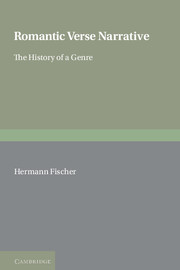Book contents
- Frontmatter
- Contents
- Preface
- List of abbreviations
- Dedication
- Introduction
- Part I The genre and it historical context
- Part II The history of the romantic tale in verse: poets, works, critics and the public
- 3 Early forms
- 4 The establishment of the genre by Sir Walter Scott, its fashionable period, and limitatins by other poets
- 5 ‘The postscript of the Augustans’ and the opposite of the romance
- 6 Ramification and dissolution
- 7 The subsequent fate of the genre
- Conclusion
- Notes
- Bibliography
6 - Ramification and dissolution
Published online by Cambridge University Press: 27 March 2010
- Frontmatter
- Contents
- Preface
- List of abbreviations
- Dedication
- Introduction
- Part I The genre and it historical context
- Part II The history of the romantic tale in verse: poets, works, critics and the public
- 3 Early forms
- 4 The establishment of the genre by Sir Walter Scott, its fashionable period, and limitatins by other poets
- 5 ‘The postscript of the Augustans’ and the opposite of the romance
- 6 Ramification and dissolution
- 7 The subsequent fate of the genre
- Conclusion
- Notes
- Bibliography
Summary
To keep the literary kinds severely apart is one of those classicist precepts of which the breach and the observance are (in right hands) equally to the advantage of literature.
C. H. Herford, Introduction to his edition of the Narrative Poems of Shelley, London, 1918The poets and works discussed thus far are a representative selection of the mass of narrative verse literature that began with Scott. The purpose of examining them more closely was to show how Scott fulfilled the demand for an epic form suited to the times; how Scott's model inspired a large number of rather unoriginal imitators; how Wordsworth tried to exploit this romance form for his own poetic purposes; how the new type of poetry became so fashionable that even the representatives of conservative taste succumbed to it or at least attempted syntheses between the old and the new, which was naturally not a very promising line of development; and finally how Grabbe in his later works produced something that was the complete opposite of the ‘genre’, and that, although the mentality behind it was entirely different, would scarcely have been possible without the existence of Scott's form of literature and the success this had had.
In the preceding discussion of the works of individual poets it was sometimes necessary to abandon the chronological order and move ahead of events. We will now return to the situation in 1812 and 1813.
- Type
- Chapter
- Information
- Romantic Verse NarrativeThe History of a Genre, pp. 146 - 198Publisher: Cambridge University PressPrint publication year: 1991



